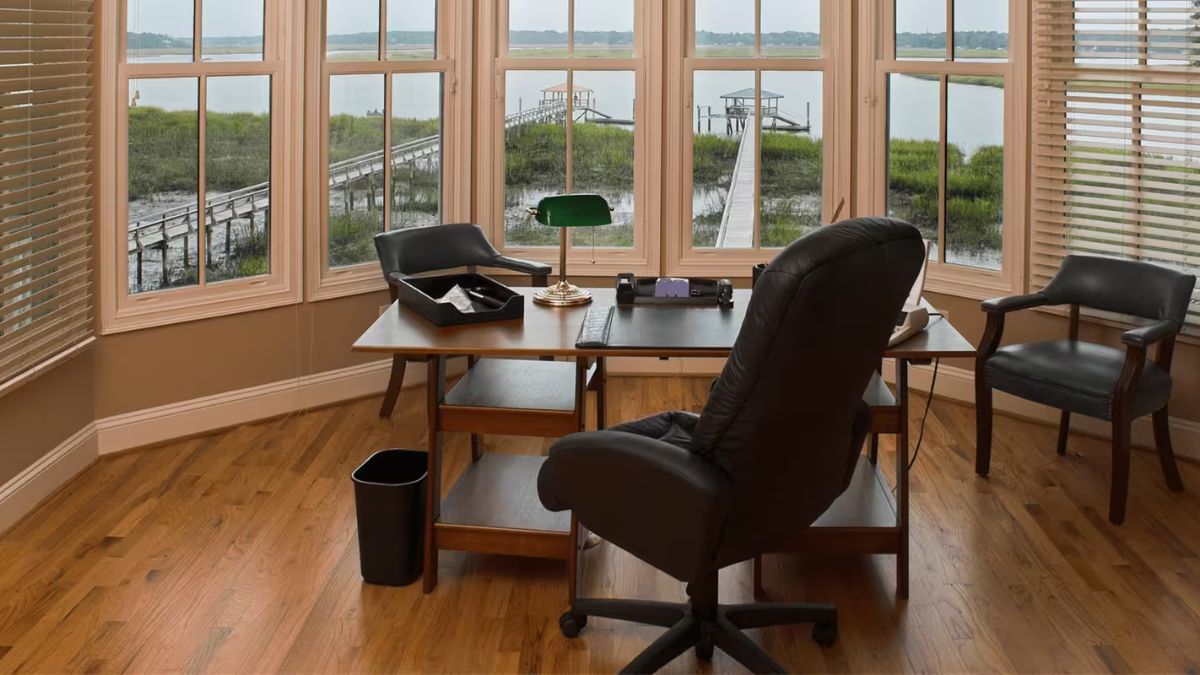TOPIC
Creating a Comfortable Home Office: Key Steps and Tips

For most people, having a home office has become a matter of survival in this age of digital technology. If you work full-time remotely but also need a space in your house to organize your family’s tasks and projects, having a comfortable and efficient home office can play a large role in enhancing your productivity and well-being. The following are some of the main recommendations and ways to help you design the ideal workspace at home.
Step 1
Choose comfortable furniture. The desk and chair are the heart of the home office, as it is in the home environment that you find your comfort in while working. However, do not think that with a classic writing desk and a comfortable chair with a backrest, you have achieved creating a comfortable environment. Actually, this kind of setup often ends up as chronic back pain, ultimately losing productivity.
When choosing a desk, it’s important to pick furniture that is as convenient as possible for work: a spacious tabletop, a place for a laptop or computer, and the presence of drawers and shelves. Do not forget the work surface height, because a desk that is too low will make you bend over, while a desk that is too high will provoke shoulder and wrist pain. Ideally, the desk should be in the range of 80-90 cm. You can check for a model that goes well for your height, otherwise, you can decide on an adjustable chair to address these shortcomings. So it’s important to pick a chair that won’t cause discomfort during work. Each person finds the most convenient option for them which can be a soft chair on four legs or a classic chair with armrests. However, an ergonomic chair that supports your position during the working process is most recommended. In addition to enabling you to adjust the seat height, it has a stand-alone backrest, which is supportive, and also, has options and wheels for moving.
By the way, you can even forgo a chair altogether. Scientists say that sitting for a very long time is even worse for your back. The majority of companies have the practice of offering specially designed high desks where people do their job standing.
Step 2
Lighting. When organizing your home office, always use as much sunlight as possible. Sunlight is known as a health booster and a crucial instrument to save your sight during work hours. The best place to put your desk is near the window or as close as possible, with your face turned in the window direction. Take the opportunity now and then to look out the window, and instead of distracting you from work, it will allow your eyes to rest. When there is not enough natural light, add more lighting. For example, you can set up a desktop lamp or suspend a ceiling light above the desk. Moreover, such a lamp should emit bright and warm light, perfect for extended work hours.
Step 3
Air conditioning. It’s essential for a home office to have the right temperature in place to be able to function well. Installing a good air conditioning system can make it easier to control the temperature from being too cold in the winter and very hot in the summer. Professional air conditioner installation ensures the appliance’s high efficiency and long life, which implies high comfort for your job.
Step 4
Soundproofing. Your workplace must be soundproofed with the operating principle of its impact on your productivity and motivation in mind. If you don’t want to be bothered by noise issues, you should equip your entrance with the best quality doors. They can be either sliding or like the conventional ones. A home office should be a comfortable place where the disturbances from outside are kept off.
Step 5
Wall color. Wall decoration is not less important than optimizing the lighting in the room because the better the comfort of the ambiance, the more productive, high-performing, and happy the worker is. Select warm shades, such as yellow, orange, red, green, and also neutral colors, such as white, and gray.
Step 6
Greening. Green potted plants at the desk are visual jewels, which positively impact productivity and mood. Go for simple plants like ficus or Chlorophytum that can cleanse the air. A home office is a unique all-in-one place that helps you organize your schedule to accomplish your tasks at maximal creativity levels.
Conclusion
A comfortable home office is created through careful planning and working out details with attention. On the one hand, the focus should be on good ergonomics, lighting, room air quality, pencils, and temperature control while on the other hand, personalization should be the dominant feature. The space thus created can lift your productivity and well-being. Remember, the chic little home office is not a workplace but it will help you in your success and happiness.
TOPIC
Discovering Babybelletje: The Adorable World of Miniature Delight

Introduction to Babybelletje
Welcome to the whimsical world of Babybelletje, where charm and creativity collide in delightful miniatures. If you’ve ever marveled at tiny treasures that spark joy and ignite imagination, you’re in for a treat. These enchanting little creations are more than just collectibles; they encapsulate stories, emotions, and memories in their petite forms. Whether you’re a seasoned collector or new to this adorable realm, Babybelletje offers something special for everyone. Dive into the captivating journey of miniature delight as we explore its origins, artistry, benefits of collecting, and tips on starting your own collection!
History and Origins of Miniature Delight
The history of miniature delights, including the enchanting babybelletje, dates back centuries. Artists and craftsmen have long been captivated by the charm of tiny creations. Miniatures served as symbols of wealth and status in various cultures.
In Europe during the Renaissance, intricate miniatures became popular among aristocrats. These delicate pieces often adorned lavish homes or were displayed in cabinets to showcase craftsmanship.
As time passed, miniatures evolved into a beloved hobby for many. The Victorian era saw an explosion in miniature dollhouses filled with meticulously crafted furniture and accessories. This period ignited a passion that continues today.
Today’s babybelletje embodies this spirit of creativity and nostalgia. Each piece tells a story while inviting collectors into its whimsical world. From playful animals to detailed scenes, these tiny treasures spark joy for enthusiasts around the globe.
The Art of Creating Miniatures
Creating miniatures is a delicate art that requires both patience and precision. Each tiny piece tells a story, capturing the imagination in its small form.
Artists often start with sketches to visualize their ideas. These blueprints guide them through the intricate process of crafting each element.
Materials play a crucial role too. From polymer clay to wood, choosing the right substance can elevate a miniature from simple to spectacular.
Attention to detail is essential in this craft. Every paint stroke or texture adds depth and character, bringing life into these little worlds.
Lighting also enhances their charm. A strategically placed lamp can cast enchanting shadows, making viewers feel as if they’ve stepped into another realm.
Miniature creation is not just about size; it’s an exploration of creativity that invites you to see things from an entirely new perspective.
Exploring the World of Babybelletje
Stepping into the enchanting world of Babybelletje is like entering a whimsical dream. Each piece tells a story, capturing the essence of creativity and imagination.
From tiny figurines to miniature food replicas, every creation invites admiration. Artists pour their hearts into crafting these delightful treasures, showcasing intricate details that capture our attention.
The variety is astonishing. You can find everything from adorable animals to charming household items. It’s not just about aesthetics; it’s about evoking joy in those who encounter them.
Venturing deeper reveals communities of enthusiasts dedicated to sharing their collections and experiences. Online forums buzz with excitement as collectors trade tips and showcase their latest finds.
Exploring this vibrant universe opens doors to inspiration and connection with others who appreciate the magic of miniatures. Each Babybelletje holds its unique charm, waiting for someone to discover it anew.
Benefits of Collecting Miniature Delights
Collecting miniature delights brings joy to many enthusiasts. Each tiny piece can evoke nostalgia and stir fond memories. The charm of these miniatures lies in their ability to transport collectors back to cherished moments.
Engaging with a collection fosters creativity. As you curate and display your pieces, your imagination flourishes. You might find inspiration for storytelling or even art projects.
Another benefit is the sense of community that often develops among collectors. Sharing experiences and discoveries creates bonds, enriching the collecting journey. Online forums and local clubs offer platforms for discussion and collaboration.
Moreover, collecting miniatures can be a form of mindfulness practice. Focusing on each detail encourages relaxation and concentration away from daily stressors. It’s an enjoyable way to unwind after a long day.
Some items may appreciate in value over time, making this hobby not just fulfilling but potentially rewarding as well.
Tips for Starting Your Own Collection
Starting your own Babybelletje collection can be a delightful adventure. Begin by defining what draws you to miniatures. Is it their charm, the intricacy of design, or perhaps the nostalgia they evoke?
Next, set a budget. Miniature collecting can range from affordable finds to rare treasures. Knowing your limits helps maintain focus and prevents impulse buys.
Visit local shops, flea markets, and online platforms dedicated to miniatures. Each venue offers unique pieces that tell different stories.
Join collector groups or forums for inspiration and tips. Sharing experiences with fellow enthusiasts enriches your journey.
Document each addition to your collection with photos and notes about its origin. This not only tracks growth but also deepens emotional connections with each piece.
Display your miniatures creatively! Whether in shadow boxes or on shelves, showcasing them adds joy to any space while inviting admiration from guests.
Conclusion: Embracing the Charm of Babybelletje
Babybelletje captures the heart in a way few things can. The world of miniatures is filled with charm and creativity, offering endless opportunities for exploration. Whether you’re drawn to their intricate designs or the nostalgia they evoke, there’s something undeniably special about each piece.
Collecting these delightful treasures not only provides joy but also connects you with a community that shares your passion. As you embark on your own journey into the realm of Babybelletje, you’ll find yourself surrounded by inspiration and imagination.
Embrace this adorable world and let it add a sprinkle of whimsy to your life. Each miniature tells a story waiting to be discovered, bringing warmth and happiness wherever it goes. Enjoy the adventure as you build your collection—there’s magic at every turn!
TOPIC
Debunking Myths Surrounding Wapbald: Facts vs. Fiction

Introduction to Wapbald and its popularity
Wapbald has taken the online world by storm, captivating users across various platforms with its unique blend of creativity and community. From art enthusiasts to music lovers, this phenomenon seems to resonate with people from all walks of life. However, like many trends that rise in popularity, Wapbald is shrouded in a cloud of myths and misconceptions. It’s time to peel back the layers and explore what Wapbald truly represents versus what some may believe it does. Let’s dive into these common myths surrounding Wapbald and uncover the facts behind this vibrant community!
Myth 1: Wapbald is only for teenagers and young adults
Wapbald has often been labeled as a platform strictly for the younger crowd. Many assume that only teenagers and young adults participate in this vibrant online community. However, this perspective is overly simplistic.
People of all ages engage with wapbald. It’s not uncommon to find users in their 30s, 40s, and even beyond sharing their creativity and experiences. The content varies widely, appealing to diverse interests across age groups.
This platform fosters connections among individuals from different generations. Users share stories that resonate with life stages unique to each demographic.
Creativity knows no age limits. Whether it’s art, music or writing, wapbald provides an outlet for self-expression regardless of how old you are. By embracing this diversity, the community thrives on collaboration and support among its members.
Myth 2: Wapbald promotes dangerous behaviors and violence
One common misconception is that wapbald glorifies dangerous behaviors and violence. Critics often point to certain content as evidence of this trend.
However, the reality is more nuanced. Many creators use wapbald to explore themes in a safe space, rather than encourage harmful actions. They address real-life issues, allowing for discussion and understanding.
Studies reveal that most participants engage with content focusing on creativity, humor, and community connection—not aggression or harm. In fact, platforms like these often showcase positive messages promoting resilience and support among users.
Moreover, many influencers actively discourage violent behavior within their communities. The thriving culture around wapbald emphasizes empathy and self-awareness over destruction or negativity.
People frequently find solace in shared experiences through storytelling rather than sensationalism. This approach fosters deeper connections while dismantling the myth of inherent danger associated with wapbald participation.
Myth 3: Wapbald is solely about romantic relationships and hookups
Wapbald is often misunderstood. Many think it’s just a platform for romantic encounters and casual flings. This perspective overlooks its broader purpose.
Users connect over shared interests, hobbies, and creative pursuits as much as they do about dating. Communities form around music, art, gaming, and more. Friendships blossom here too.
People find like-minded individuals who inspire creativity or foster collaboration on projects. These connections can lead to lasting friendships that extend far beyond romance.
While some users may seek relationships, the essence of Wapbald goes deeper than mere hookups. It thrives on community engagement and self-expression in various forms.
The truth behind these myths – statistics and studies
Research reveals a different story about wapbald than commonly believed. Studies show that users span all age groups, with significant participation from adults over 30. This counters the myth that it’s just for teens and young adults.
When examining claims of violence, data indicates that most interactions remain positive and supportive. A recent survey found that nearly 75% of participants report feeling safer in their online communities.
The stereotypes surrounding romantic relationships are also misleading. While some individuals seek connections, many use wapbald to express creativity or share interests outside romance.
These findings highlight how misconceptions can overshadow the diverse experiences within the wapbald community. The reality is far more nuanced than simple myths suggest, reflecting an engaging platform for various forms of expression.
Positive aspects of Wapbald – building communities, self-expression, and promoting creativity
Wapbald has emerged as a vibrant platform where individuals can connect, share experiences, and foster communities. Users from all walks of life come together, creating spaces that encourage dialogue and support.
Through Wapbald, self-expression flourishes. People showcase their talents—be it through art, writing, or music. This freedom to express oneself without judgment empowers users to explore their identities.
Creativity is another cornerstone of the Wapbald experience. The platform inspires innovative ideas and collaborations among its members. Many have transformed personal stories into artistic projects that resonate with others.
In this digital landscape, friendships blossom over shared interests. Members often find like-minded individuals who inspire them to grow and evolve in meaningful ways. Each interaction contributes to a sense of belonging that’s hard to replicate elsewhere on the internet.
Conclusion
Wapbald has garnered a lot of attention, sparking various myths that often overshadow its true essence. While it’s common to associate Wapbald with specific age groups or behaviors, the reality is far more nuanced. The platform serves as much more than just a space for teenagers; it’s a vibrant community filled with individuals from all walks of life.
The misconceptions surrounding Wapbald suggest it encourages violence or risky behavior, but studies show that most users engage in positive interactions and creative expression instead. It’s not merely about fleeting romances or hookups; rather, it’s about forming connections and sharing experiences.
People find solace in this online space by expressing themselves freely and creatively. They build communities that foster support and mutual understanding. This aspect truly highlights the potential of Wapbald to be a force for good—a place where creativity thrives and friendships blossom.
Understanding these facts can help dispel the myths associated with Wapbald while appreciating its role in modern digital culture. Engaging openly on such platforms allows us to redefine perceptions based on informed insights rather than stereotypes alone. With an open mind, perhaps we can embrace what makes Wapbald special—a hub of creativity, connection, and genuine self-expression without the baggage of unwarranted judgments.
TOPIC
Top 5 Reasons to Explore Valplekar Today

Introduction to Valplekar
Nestled away from the hustle and bustle of everyday life, Valplekar is a hidden gem waiting to be discovered. With its rich history, stunning landscapes, and vibrant culture, this destination offers something for every type of traveler. Whether you’re an adventure enthusiast or a foodie looking to indulge in local delights, Valplekar promises an unforgettable experience. Let’s dive into the top five reasons why you should pack your bags and explore Valplekar today!
Historical and Cultural Significance of Valplekar
Valplekar is a treasure trove of history and culture. Its roots run deep, intertwined with ancient traditions that tell stories of resilience and heritage.
The architecture reflects various influences, showcasing beautiful structures from different eras. Each building has its own tale, inviting visitors to explore the past.
Local festivals bring the community together in vibrant celebrations. These events are filled with music, dance, and rituals that honor age-old customs.
Artisans continue traditional crafts passed down through generations. Their work not only preserves history but also provides insight into local life.
Exploring museums reveals artifacts that narrate Valplekar’s journey through time. It’s a place where every corner whispers secrets waiting to be discovered by curious travelers.
Natural Wonders and Outdoor Activities in Valplekar
Valplekar is a hidden gem for nature lovers and adventure seekers alike. Lush greenery envelops the region, presenting breathtaking landscapes that invite exploration.
Hiking trails wind through dense forests and along pristine rivers. Each path reveals stunning views and chances to spot local wildlife. The tranquility of the surroundings makes every trek memorable.
For those who prefer water activities, the nearby lakes offer kayaking and paddleboarding opportunities. The calm waters reflect the sky’s hues, creating an idyllic backdrop for a day on the water.
Birdwatchers will find Valplekar equally captivating. Numerous bird species inhabit this area, making it a haven for enthusiasts with binoculars in hand.
Whether you’re scaling hills or relaxing by serene shores, Valplekar’s natural beauty provides endless outdoor adventures waiting to be discovered.
Unique Local Cuisine and Dining Options
Valplekar boasts a vibrant culinary scene that reflects its rich cultural heritage. Locals pride themselves on using fresh, seasonal ingredients sourced from nearby markets.
One must-try dish is the traditional Valplekar thali, a colorful platter featuring an assortment of flavors and textures. Each element tells a story of the region’s history and customs.
Street food lovers will find delight in small stalls offering mouthwatering snacks like spicy chaat and savory vada pav. These bites are perfect for fueling your adventures around town.
For those seeking fine dining, upscale restaurants present innovative takes on classic recipes while maintaining authenticity. Pair your meal with local beverages for an immersive experience.
Vegetarians will feel especially welcome here; plant-based dishes abound with creative twists that satisfy all palates. Whether you crave casual or elegant dining, Valplekar offers something to tantalize every taste bud.
Accommodation and Transportation Options in Valplekar
Valplekar offers a variety of accommodation options to suit every traveler’s needs. From cozy guesthouses and boutique hotels to luxurious resorts, you can find a place that fits your budget and style. Many lodgings provide stunning views, allowing visitors to enjoy the natural beauty right from their room.
Getting around Valplekar is straightforward. The local transport system includes buses and taxis, making it easy for tourists to explore the area without hassle. For those who prefer independence, renting a bike or scooter is an excellent choice.
The scenic roads winding through Valplekar invite leisurely drives too. With ample parking available at most attractions, you can easily visit all the must-see spots in comfort. Whether you’re looking for rustic charm or modern convenience, Valplekar’s accommodations have something special waiting for you.
Experiences and Adventures in Valplekar
Valplekar is a treasure trove of experiences waiting to be uncovered. For thrill-seekers, the rugged landscapes offer everything from rock climbing to exhilarating mountain biking trails. Each twist and turn reveals breathtaking vistas that make every effort worthwhile.
Nature enthusiasts can immerse themselves in guided eco-tours through lush forests. Birdwatching here is nothing short of magical, with vibrant species flitting between trees.
For those seeking cultural immersion, local festivals showcase traditional crafts and folk music. Participating in these events connects visitors with the rich heritage of Valplekar.
Adventurous souls might also find joy in water sports at nearby rivers or lakes. Whether it’s kayaking or fishing, there’s something for everyone to enjoy on the water.
Don’t forget about hiking! Trails meander through captivating scenery, leading you to hidden gems only accessible by foot. The sense of discovery will keep you coming back for more adventures in this enchanting locale.
Conclusion: Why You Should Visit Valplekar Now
Valplekar beckons travelers with its rich tapestry of history, culture, and nature. Each corner of this captivating destination tells a story, waiting to be explored. The blend of historical landmarks and cultural experiences offers a unique glimpse into the past while celebrating the present.
Nature enthusiasts will find endless adventures in Valplekar’s pristine landscapes. From hiking trails to serene spots for reflection, there is no shortage of outdoor activities that showcase the region’s beauty.
Food lovers will delight in discovering local cuisine that tantalizes the taste buds. Dining options range from cozy eateries serving traditional dishes to vibrant markets brimming with flavors.
Whether you seek comfortable accommodations or convenient transportation options, Valplekar has something for every traveler. Exploring this gem becomes effortless and enjoyable.
The experiences available are diverse and enriching—perfect for adventurers looking for something memorable. Immerse yourself in local traditions or embark on thrilling escapades; both promise unforgettable moments.
This enchanting destination deserves a spot on your travel list now more than ever as it promises an array of delights waiting just for you!
-

 TECHNOLOGY6 months ago
TECHNOLOGY6 months agoTop 10 Must-Read Stories from Kristen Archives You Can’t Miss
-

 TECHNOLOGY11 months ago
TECHNOLOGY11 months agoSky Bri Net Worth Revealed: How She Built Her Financial Empire
-

 TOPIC1 year ago
TOPIC1 year agoBasement Renovation Contractors: How They Tackle Structural Issues During Renovations
-

 TOPIC8 months ago
TOPIC8 months ago5 Reasons the //Vital-Mag.Net Blog Dominates Lifestyle
-

 TOPIC6 months ago
TOPIC6 months agoTop 10 Articles from the ://Vital-Mag.net Blog That You Can’t Miss
-

 CRYPTO10 months ago
CRYPTO10 months agoCrypto30x.com Review: Is It the Right Platform for You?
-

 BUSINESS6 months ago
BUSINESS6 months agoTraceLoans Explained What You Need to Know
-

 ENTERTAINMENT3 months ago
ENTERTAINMENT3 months agoNHentai.NEF: Navigating the Popular Hentai Archive with Ease
